Abstract
Empirical studies of a social capital as a significant factor in improving the efficiency of the universities are very important for the development of higher education. However, the practical measurement of the university's social capital and the evaluation of its impact on effectiveness is challenging. This paper discusses the problems of designing a theoretical model, measurement and analysis of the social capital of the university. This study presents the results of a pilot research aimed at the developing of methodology and tools for measuring and analyzing the university's social capital. Qualitative and quantitative methods of the analysis were adopted for this study. The units of the analysis included university teachers, departments and institutes. The results of the study showed that empirical researches of the impact of a social capital on the professional activities of the university teachers is associated with a large number of factors, which requires the development of special mathematical models based on randomized algorithms and statistics. The structure of a social capital of the university is very heterogeneous and diverse, in addition to internal processes, teachers are included in various external networks and groups, acting as an element of social capital of external actors: students, graduates, employers, expert communities, stakeholders. There is a general trend of decreasing confidence in the levels of the organizational hierarchy from the department to the university.
Keywords: Educationvaluesvalue-based managementvalue-based management of educational organizations
Introduction
The problem of ensuring the competitiveness and quality of education is in the focus of research interest in recent years. The low efficiency of educational organizations is a growing concern of government and society. Education is one of the largest mass sectors of the economy, but it does not provide the expected nor tangible benefits. At the same time, social values are being destroyed and education as a social institution cannot cope with the role of preserving and reproducing these values. The growth of complexity, uncertainty and versatility of the external environment leads to increased divergence in the internal environment of educational institutions. This induced a problem of alienation in the education system, which gave bases to the phenomenon of "academic collusion" (Shipunova & Berezovskaya, 2018). At the same time, the risks of imbalance and conflicts of interests are increasing. A gap between the socio-economic changes and the renewal of the education system has been created, which is characterized by inertia, the rigidity of archaic organizational structures and status-role formats of educational activities (Leontieva & Ababkova, 2018). Comparison of value priorities of managers and employees of educational organizations indicates an imbalance of value systems. Thus, the terminal value priorities of management (values-goals) are grouped around the "functional stereotype" and "ideological company", while the value priorities of employees are focused within the "psychological stereotype" and "emotional company". The instrumental values (values-means) of managers are focused on the most complete labor return of employees, the development of professional competence, the priority is "diligence", for the stuff the priority is "self-realization", "interesting work", their instrumental values are more consistent with the concept of adaptive management.
Problem Statement
Analysis of the theory and practice of educational management points to a number of problems that make it difficult to implement models of effective management within an educational organization. This includes:
lack of empirical data on the comparative effectiveness of different models of management of educational organizations;
lack of a systematic description of the international experience and the most effective practices of value-based management, incomprehension of the possibility of its use in the management of educational organizations;
lack of objective data on the available systems of basic and instrumental values of the subjects of education and data on the level of their compliance with the strategies and priorities of educational policy.
In the literature, there is no clear understanding of the mechanisms of the influence of value systems on the formation of intangible assets of educational organizations, how value chains are created in educational organizations, how the conversion of internal value systems can benefit of stakeholders.
Thus, the actual problem is the development of a model of management of educational organizations that integrates economic and humanitarian approaches. The hypothesis of the research is connected with the proof that the optimal model of management of modern educational organizations is value-oriented management.
Research Questions
‘Value’ means any object (including ideal) that is of vital importance for the subject (individual, group, society). In a broad sense, a value can be not only abstract meanings, but also specific benefits that are important for the subject. In a narrower sense, it is customary to speak of values as spiritual ideas embodied in concepts that have a high degree of generalization. Forming in consciousness, these values are comprehended during the development of culture. The study of value systems is of interest from the point of view of the possibility of predicting social behavior. In turn, value orientations are a reflection within the human consciousness of those values that are recognized by them as strategic life goals and common ideological orientations.
According to Fromm (1959), there is usually a gap between what a person considers his values and the actual values that he is guided by and is not aware of. The discrepancy between conscious and ineffective values, on the one hand, and unconscious and effective – on the other, empties the person and, as a result, deprives him of life stability.
One of the first references in value-based management is found in the works of A. Fayol (corporate spirit) and C. Barnard (uniting management), who acknowledged the role of "organizational morality" in improving the efficiency of activities. In the late 1970s, the attention of scientists focused on the concept of organizational culture in the works by E. Schein, K. Cameron and R. Quinn, D. Dennison, K. Fey, T. Deal and A. Kennedy, etc., the study of which marked the beginning of a systematic search for universal value measurements by G. Hofstede, F. Trompenaars, which was further developed in the concept of resource exchange by Lammers and Hickson (1979), the theoretical analysis of the value bases of cross-cultures, acculturation and cultural differences by Matsumoto (1992). Studies conducted by Trompenaars and Hampden-Turner (1998) formed the basis for the study of the impact of values on business.
A significant place in the concept of value-oriented management is occupied by works in which the nature and essence of values are studied, classifications of values and their typology are given Rokeach (1968), T. Adorno, M. Schwartz, R. Nevitt Sanford. Rokeach (1968) is one of the first to present value structures as a system of interrelated values, highlighting two types of values: terminal and instrumental. A similar typology is offered by Lebow (1993), who also distinguishes two types of values: human (values-goals) and business (values-means). D. Olport based classification of values on the typology of E. Spranger, who identified six components: theoretical, economic, aesthetic, social, political and religious. Schwartz and Bilski (1987) offer a meaningful analysis of values, which includes two aspects: the basis of the typology of values and structural relationships between different types of values.
The influence of globalization on the transformation of values is studied by Ronald Inglehart, who analyzes the mechanisms of changes in value systems depending on economic, social and technological factors. A unique database - "World Value Reviews" (WVS), based on the results of Welzel and Inglehart’s (2006) research, gives opportunities for comparative studies and convincingly shows that the processes of economic and technological transformations lead to changes in value systems. R. Inglehart formulated the theory of intergenerational change of values based on two key hypotheses: the "value significance of the missing" and the "socialization lag".
The main provisions of the concept of public value were formulated in the works of M. Moore, B. Bozeman, P. Jackson, M. Cole and G. Parston. Among the most significant works in this field can be identified as, for example, "Creating Public Value Strategic Management in Government" by Moore (1995); "Public Value Failure: When Efficient Markets May Not Do" by Bozeman (2002); "Public Sector Added Value: Can Bureaucracy Deliver?" by Jackson (2001). Since the beginning of the 21st century the concept of public value has been used in theoretical studies and actively implemented in management practice as a basis for the development of methodological recommendations for improving activities, for example at "Improving public services: evaluation of the best value pilot program"; "Best value in public service. Guidance to accountable officers"; "Creating value: findings from public service innovation focus groups" and etc.
Public value, in a broad sense, can be defined as the value to society created as a result of the activities of the organization, as Kelly, Mulgan and Moers (2002) showed. Its measure can be considered the degree of satisfaction of members of society with the quality of products and services provided by the organization and the degree of trust in it (Bhattacharjee, 2013). Thus, value added is based on an implicit or explicit contract between society and the organization. The concept of public value thus provides criteria for measuring and evaluating the social responsibility of an organization, as well as for making decisions about the allocation of resources and the choice of the most appropriate system for the provision of public goods (Russell, 1995).
The concept of value analysis became very popular among researchers in the 1990s. Evaluation of the effectiveness of organizations from the point of view of shareholders' interests has become generally recognized in economic theory and management. It is based on indicators traditionally used in financial analysis. McTaggart suggests the term "value-based management" (VBM) to denote such a model. McTaggart, Kontes and Mankins (1994) formulated the concept of value-based management, which establishes a direct link between the strategy of the organization and its value to the consumer (shareholder value maximization, SVM). The detailed analysis of perspective models of value-based management shows that cultivation of values leads to economic success and growth of the financial and non-financial value of the organization (Doyle, 2000). Research of Badaracco shows that values have a hidden or explicit influence on decision-making leaders at all levels of the organizational hierarchy. The concept "management for value" (MfV), which emphasizes the importance of changing the culture of the organization, became the basis of a new view of management (as cited in Martin, Petty, & Wallace, 2009). The results of research conducted by the Brookings Institute suggests that tangible assets make up only 25% of the total corporate value, and the remaining 75% is non-material values (Kratz & Kroflin, 2016). These values include: intellectual property, brand, goodwill, quality management (Apevalova, Gromova, Pasholikov, & Trofimova, 2018), etc. Value analysis can be supplemented by the concept "value stream creation" proposed by Porter in 1985, which suggests that effective management can create value that affects the perception of the organization by consumers.
Thus, values become one of the fundamental categories of the modern theory of management. However, due to the general degradation of societal values and the spread of atomic structures, the ideas of value-based management have not found widespread practical application (Alexankov, Trostinskaya, & Pokrovskaia, 2018). In addition, the problem is that in order to implement value-related procedures and rules and norms of organizational activity, management requires skills and experience in identifying staff values and cultivating strategic values, as well as changes in personal and group values that management does not fully possess (Taylor & Ortega, 2004). Unfortunately, many modern managers do not have the conceptual knowledge of the analysis of the organization’s values. Despite the fact that they own separate tools, this is not enough for organizational values to serve as an effective managerial tool to better achieve the goals of the organization.
Purpose of the Study
The general objective of the study was to test the assumption that value systems significantly affect the effectiveness and quality of educational organizations (the hypothesis of the relationship between value systems and indicators of individual and group productivity). A particular objective of the study was to measure and do a comparative analysis of the basic and instrumental values of the stuff of educational organizations according to their level and type, to identify similarities and differences (congruence) of value systems, as well as to determine the potential impact of value-based management on the effectiveness and quality of educational organizations.
Research Methods
The analysis of the value system was carried out by the aggregation of empirical data into a set of integrative relations expressed as a factor model (Akopova & Chernyavskaya, 2014; Zakharova & Krasnoschokov, 2016). For comparative analysis, it is necessary to modify the semantic differential, which allows to reconstructing the group structure of values according to the degree of influence on them by various factors (Ababkova, Pokrovskaia, & Trostinskaya, 2018). The results of scaling are processed in a standard way: factor analysis of data is carried out, the names of the identified factors are given, factor weights of scaling objects are calculated and scaling objects in accordance with their weights are located in the space of the selected factors. The use of the principal component method allows for the combination of a variety of interrelated individual and group values in the main components (Fletcher & Darlene, 2004), formally represented in the form of coordinate axes, through which the value space is ordered.
Adequate for the purposes of the study is the use of methods of international surveys, such as, for example, World Values Survey (WVS) and European Social Survey (ESS) (Kumar, 2014). For the evaluation of values, the Rokeach method was used.
The study interviewed 50 managers and 100 teachers of educational institutions of different types. All respondents were asked to answer the question: "What are the most significant values of your organization that you use for planning and decision-making?" The answers should have shown an understanding of value, the difficulty of formulating the basic and instrumental values of the organization and the difficulty of their practical use to improve organizational efficiency.
Findings
The analysis of the respondents' answers allowed to identify some problem areas in determining the value priorities of management of educational organizations:
1. Managers' perception of the category “value” is identical to the categories “purpose” and “function”.
Thus, the following values were named as the basic values of educational organizations:
giving classes in accordance with the requirements of educational standards (59%);
using modern pedagogical technologies (46%);
design and creation of educational services according to the needs of consumers (38%), etc.
2. Lack of understanding of the importance of value-based management as a mechanism to improve organizational efficiency.
The question was "Can you determine, on a 10-point scale, the place of organizational values in the planning and decision-making processes?». The distribution of responses is shown in Figure
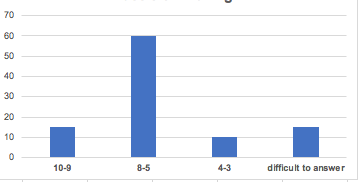
3. Mixing of personal values of the managers with organizational values
The respondents named the values which should be considered for decisions:
material wealth (32%);
gaining credibility (26%);
success and prosperity (24%).
Thus, the study revealed the managers' misunderstanding of the category "value", underestimating the role of values in the management process.
The reasons for this may be:
the orientation of training programs for management in accordance with instructions, i.e. functional and program-targeting management;
managers' perception of the category "value" as a purely philosophical concept that is not related to management practice.
In addition, the study conducted a survey of 100 employees of educational organizations. Most respondents, as well as managers, found it difficult to determine organizational values.
So, the following answers were received to the question: "What priority values are taken into account by management in the decision?" (Figure
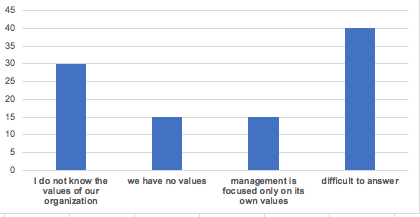
The lack of understanding the value priorities of the educational organization leads to:
formation of staff loyalty based on common norms, not on personal beliefs, this has a negative impact on job satisfaction;
increased staff turnover, which leads to increased costs of recruitment, selection, training and adaptation of staff;
high level of conflict due to organizational reasons;
problems in the team building process;
lack of corporate spirit and team cohesion;
low level of staff motivation, etc.
At the next stage of the study, respondents were required to rank values according to the degree of importance (basic and instrumental separately).
The distribution of managers ' responses to basic values is shown in Figure
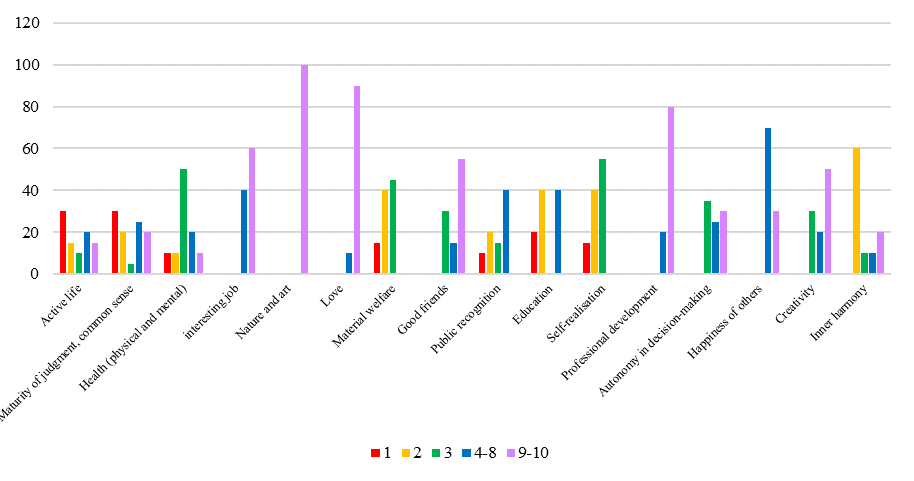
The instrumental values of the management were (Figure
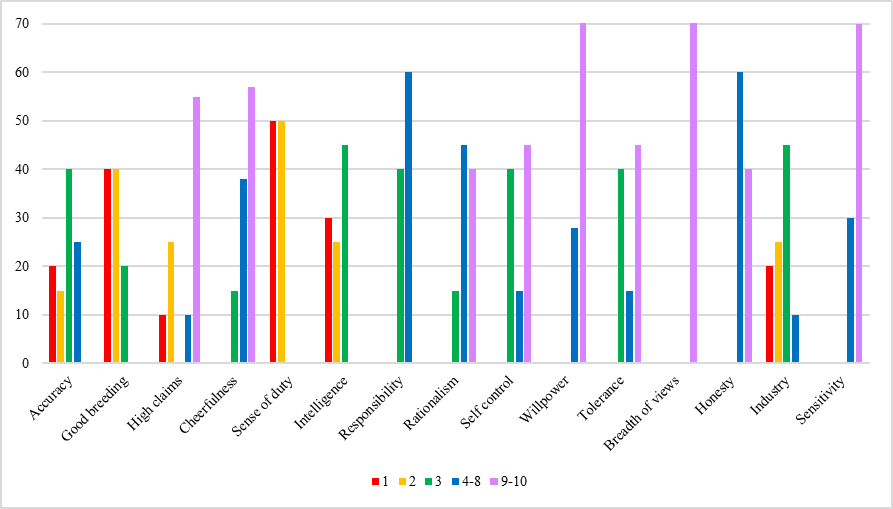
Personnel listed the terminal values that should be considered in the management of educational organizations as follows (Figure
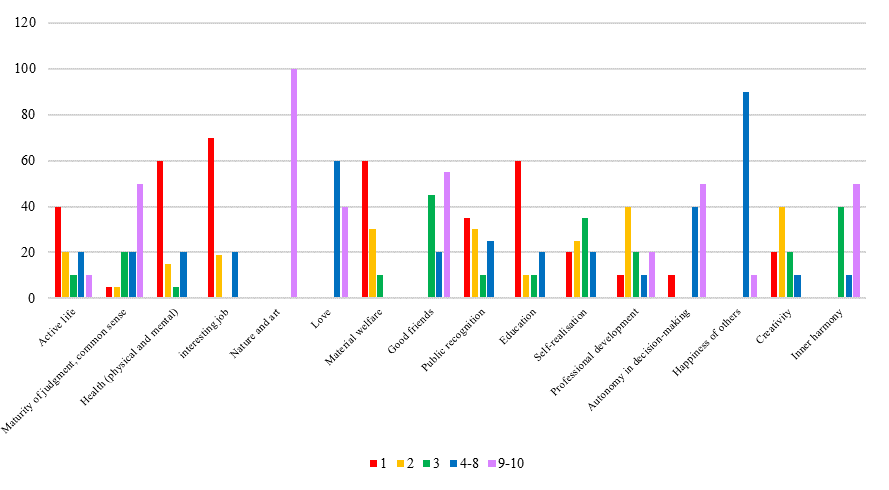
The instrumental values of teachers were (Fig. 06):
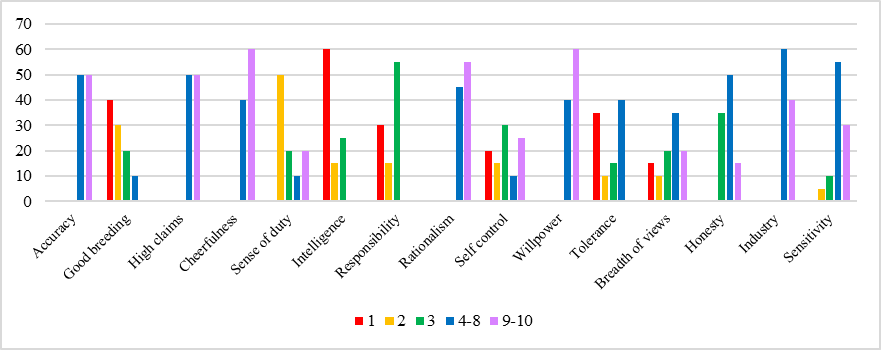
The distribution of basic and instrumental values of managers and teachers by ranks can be compared according to the data given in Table
In contrast to management, which has a clear attraction to the ideology of organization, the staff prefers emotional organization, for which the values were:
work satisfaction;
care for employees;
maintaining a corporate spirit;
socio-psychological climate;
variety of non-material incentives to work;
minimization of rules and restrictions that make it difficult to realize creative potential;
low level of conflict;
management flexibility.
Conclusion
It is very important to consider the values of management and employees, maintain no conflict of interest in value-based management. Comparison of value priorities of managers and employees of educational organizations indicates an imbalance of value systems. Thus, the terminal value priorities of management (values-goals) are grouped around the "functional stereotype" and "ideological company", while the value priorities of employees are focused within the "psychological stereotype" and "emotional company". The instrumental values (values-means) of managers are focused on the most complete labor return of employees, the development of professional competence, the priority is "diligence", for the staff the priority is "self-realization", "interesting work", their instrumental values are more consistent with the concept of adaptive management.
The reasons for the value imbalance in educational organizations are:
the prevalence of administrative methods of management and the attraction to an authoritarian management style;
management’s distrust of employees;
low level of staff involvement in decision-making.
Acknowledgments
The reported study was funded by RFBR, projects number 18-013-00646\18 and 19-011-33058\19.
References
- Ababkova, M. Y., Pokrovskaia, N. N., & Trostinskaya, I. R. (2018). Neuro-technologies for knowledge transfer and experience communication. European Proceedings of Social & Behavioural Sciences, 35, 10-18.
- Akopova, M., & Chernyavskaya, V. (2014). Evaluation of Academic Science: Perspectives and Challenges: Analizing Experience of St. Petersburg Politechnical University. Zeitschrift fur Evaluation, 2, 348-357
- Alexankov, A. M., Trostinskaya, I. R., & Pokrovskaia, N. N. (2018). Industry 4.0 Requirements For Quality Of Human Capital And Competencies Formed Within Educational Institutions. The European Proceedings of Social & Behavioral Sciences, 34, 26-34.
- Apevalova, Z. V., Gromova, L. A., Pasholikov, M. S., & Trofimova, I. V. (2018). Integrative Models of the Future Teachers Education Quality Assessment. The European Proceedings of Social & Behavioural Sciences, 51, 1428-1438.
- Bhattacharjee, S. (2013). Total customer value management: transforming business thinking. South Asian Journal of Management, 20, 158-169
- Bozeman, B. (2002). Public‐value failure: When efficient markets may not do. Public administration review, 62(2), 145-161.
- Doyle, P. (2000). Value-Based Marketing: Marketing Strategies for Corporate Growth and Shareholder Value. New York: Wiley.
- Fletcher, H. S., & Darlene, B. (2004). Managing for Value: Developing a Performance Measurement System Integrating Economic Value Added and the Balanced Scorecard in Strategic Planning. Journal of Business Strategies, 21, 1-17.
- Fromm, E. (1959). Values, Psychology, and Human Existence. In A. H. Maslow (Ed.). New Knowledge in Human Values. New York: Harper & Bros.
- Jackson, P. M. (2001). Public sector added value: can bureaucracy deliver? Public Administration, 79(1), 5-28.
- Kelly, G., Mulgan, G., & Muers, S. (2002). Creating Public Value: an analytical framework for public service reform. London: Prime Minister’s Strategy Unit.
- Kratz, N., & Kroflin, P. (2016). The Relevance of Net Working Capital for Value Based Management and Its Consideration within an Economic Value Added (EVA) Framework. Journal of Economics & Management, 23, 21-34.
- Kumar, S. V. (2014). Attaining Organizational Happiness through Value-Based Management - a Conceptual Framework. Advances in Management, 7, 7-19.
- Lammers, C. J., & Hickson, D. J. (Eds.). (1979). Organizations Alike and Unlike: International and Inter-institutional Studies in the Sociology of Organizations. London: Routledge.
- Lebow, D. (1993). Constructivist values for instructional systems design: Five principles toward a new mindset. Educational Technology Research and Development, 41, 4-16.
- Leontieva, V. L., & Ababkova, M. Y. (2018). Image of Disciplines and University: A New Approach to Research. The European Proceedings of Social & Behavioural Sciences, 51, 874-881.
- Martin, J. D., Petty, W., & Wallace, J. S. (2009). Value-Based Management with Corporate Social Responsibility. (2nd ed.). New York: Oxford University Press
- Matsumoto, D. (1992). American-Japanese Cultural Differences in the Recognition of Universal Facial Expressions. Journal of Cross-Cultural Psychology, 23(1), 72–84.
- McTaggart J. M., Kontes P. W., & Mankins M. (1994). The Value Imperative, New York, NY: The Free Press.
- Moore, M. H. (1995). Creating public value: Strategic management in government. Harvard university press.
- Rokeach, M. J. (1968). A Theory of Organization and Change Within Value-Attitude Systems. Journal of Social Issues, 24, 3-22
- Russell, J. A. (1995). Value Management: An Incremental Approach. Frontiers of Health Services Management, 12, 44-62
- Schwartz, S. H., & Bilsky, W. (1987). Toward a universal psychological structure of human values. Journal of Personality and Social Psychology, 53(3), 550-562.
- Shipunova, O. D., & Berezovskaya, I. P. (2018). Formation of the specialist's intellectual culture in the network society. The European Proceedings of Social & Behavioural Sciences, 51, 447-455.
- Taylor, L. J. III & Ortega, R. D. (2004). Globalization, Value-Based Management, and Outsourcing Strategies and the Application of the Theory of Constraints. Academy of Strategic Management Journal, 3. 77-98
- Trompenaars, F., & Hampden-Turner, C. (1998). Riding the waves of culture. New-York, McGraw-Hill
- Welzel, C., & Inglehart, R. (2006). Emancipative Values and Democracy. Studies in Comparative International Development, 41(3), 74-94.
- Zakharova, I., & Krasnoschokov, V. (2016). International student project "Our Universities" as an example of new tools of higher education quality improvement, In M. Wilson (Ed.), Materials of the XII International Scientific and Practical Conference, «Prospects of World Science - 2016», (pp. 96-100). Sheffield, UK: Sheffield Science and Education LTD.
Copyright information

This work is licensed under a Creative Commons Attribution-NonCommercial-NoDerivatives 4.0 International License.
About this article
Publication Date
02 December 2019
Article Doi
eBook ISBN
978-1-80296-072-3
Publisher
Future Academy
Volume
73
Print ISBN (optional)
-
Edition Number
1st Edition
Pages
1-986
Subjects
Communication, education, educational equipment, educational technology, computer-aided learning (CAL), Study skills, learning skills, ICT
Cite this article as:
Trapitsin, S., Apevalova, Z., Sokolova, N., & Trofimova, I. (2019). Value-Based Management Of Educational Organizations. In N. I. Almazova, A. V. Rubtsova, & D. S. Bylieva (Eds.), Professional Сulture of the Specialist of the Future, vol 73. European Proceedings of Social and Behavioural Sciences (pp. 905-916). Future Academy. https://doi.org/10.15405/epsbs.2019.12.95
